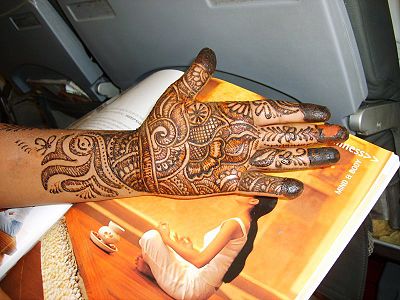Mehndi
Mehndi (or Hina) is the application of henna (Hindustani: हेना- حنا- urdu) as a temporary form of skin decoration, most popular in South Asia, the Middle East, North Africa and Somaliland as well as expatriate communities from these areas. It is typically employed for special occasions, particularly weddings. It is usually drawn on the hands and feet, where the color will be darkest because the skin contains higher levels of keratin, with which the colorant of henna, lawsone, enters a permanent bind.
Henna paste is usually applied to the skin using a plastic cone or a paint brush, but sometimes a small metal-tipped jacquard bottle used for silk painting (a jac bottle) is used. Henna can be bought at a store in a plastic or paper cones The painted area is then wrapped with tissue, plastic, or medical tape to lock in body heat, creating a more intense color on the skin. The wrap is worn overnight and then removed. The final color is reddish brown and can last anywhere from two weeks to several months depending on the quality of the paste.
The patterns of mehndi are typically quite intricate and predominantly applied to brides before wedding ceremonies. However, traditions in India, Pakistan, Bangladesh and Sudan sometimes expect bridegrooms to be painted as well. In Rajasthan (north-west India), where mehndi is a very ancient folkart, the grooms are given designs that are often as elaborate as those for brides. In Kerala (south India), henna is known as mylanchi and is commonly used by the Mappila (Muslim) community during weddings and festivals.
In Arabic and Persian speaking countries, such as Morocco, it is done for any special occasion. It is done during the seventh month of pregnancy, after having the baby, weddings, engagements, family get-togethers, as well as many other reasons to simply celebrate an event.
Mehndi decorations became fashionable in the West in the late 1990s, where they are sometimes called "henna tattoos." This term isn't accurate, because tattoos are defined as permanent surgical insertion of pigments underneath the skin, as opposed to pigments resting on the surface.
- Mehndi.jpg
Mehndi on a hand
- Eid ul azha 003.jpg
Another intricate Mehndi pattern
- Mehndi Designs and Mehndi Designers' Database
- Henna Designs
- Henna Art, History, Science and Traditions
- Contemporary and Traditional Mehndi Designs
- Sri Lanka Mehendi
- Latest Mehndi Designs
ur:حنا
Credits
New World Encyclopedia writers and editors rewrote and completed the Wikipedia article in accordance with New World Encyclopedia standards. This article abides by terms of the Creative Commons CC-by-sa 3.0 License (CC-by-sa), which may be used and disseminated with proper attribution. Credit is due under the terms of this license that can reference both the New World Encyclopedia contributors and the selfless volunteer contributors of the Wikimedia Foundation. To cite this article click here for a list of acceptable citing formats.The history of earlier contributions by wikipedians is accessible to researchers here:
The history of this article since it was imported to New World Encyclopedia:
Note: Some restrictions may apply to use of individual images which are separately licensed.
